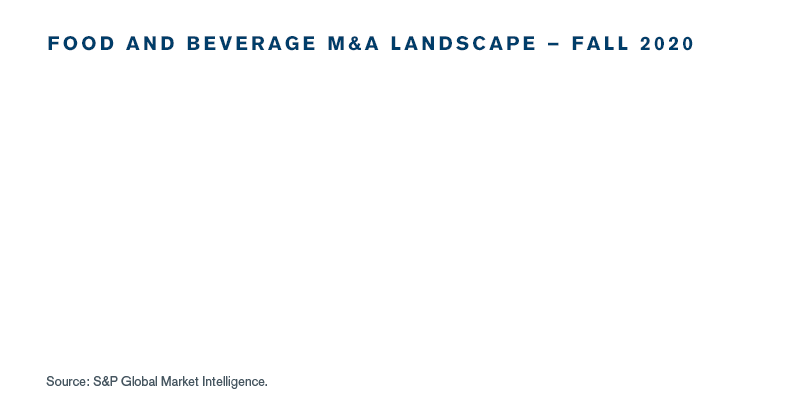While food and beverage M&A deal activity in the U.S. and Canada continued to see a downtick in the trailing twelve months (TTM) ending September 30, 2020, with 283 deals closing over the period, Q3 2020 deal volume was the highest it has been in the past five years.

The third quarter of 2020 did not produce any landmark transactions, except for the sale of Kraft Heinz’ natural cheese business to Groupe Lactails S.A. for USD 3.2 bn, which was announced on September 15, 2020.
M&A activity in the food and beverage sector is still predominately driven by strategic buyers (including companies primarily owned by private equity investors), with strategic transactions representing 83% of total deal value over the TTM. Of the 283 deals closed over the TTM, 240 (85%) were completed by privately owned buyers.
Although deal volume in Q3 2020 was up almost 8% from the previous year, with 71 deals closing over the period, compared to only 66 the year before, overall deal volume in the TTM decreased 10.2%, relative to the 313 deals closed over the TTM ending September 20, 2019.
As expected, reduced uncertainty from the pandemic in Q3 coincided with a rebound in food and beverage M&A. Businesses and consumers have adapted to “the new normal,” and credit markets have recalibrated to allow access to capital for acquisitions. Combined with pent-up demand from potential buyers, these circumstances resulted in the highest third quarter deal count in recent years. The trend will likely continue into the final months of 2020 as buyers jockey for quality assets - strategic buyers are sitting on ample cash, private equity funds have access to stable financing again and a need to place capital, and Special Purpose Acquisition Companies (SPACs) become a new vehicle for investors to create value in the food and beverage space.
On the ground, it is still a tale of two markets. Food and beverage businesses with high exposure to retail, e-commerce and food delivery have weathered the pandemic well, as consumers largely continue to eat and drink at home. Conversely, businesses that were levered to the food service sector are still experiencing reduced demand from key end markets, including restaurants, hospitality, travel and tourism, sports and entertainment. These businesses will likely remain under pressure as the threat of further restrictions loom headed into the winter, until a longer-term solution to the pandemic (i.e., an effective vaccine) is within reach.
Read the Food and Beverage M&A Landscape for more details on transaction activity, industry in-sights and sector updates.
Source: Capital IQ as of September 30, 2020
Note: M&A deal count is defined by a list of subsectors viewed as the best representation of the industry
Connect with Us
Stay Ahead with Kroll
Consumer, Food, Restaurant and Retail Investment Banking
Consumer, Food, Restaurant and Retail expertise for middle-market M&A transactions.
Distressed M&A and Special Situations
Kroll professionals have advised hundreds of companies, investors and other stakeholders at all stages of distressed transactions and special situations.
Transaction Advisory Services
Kroll provides comprehensive due diligence, operational insights, and tax structuring support, assisting private equity firms and corporate clients throughout the deal lifecycle.
Transaction Opinions
Our Transaction Opinions solutions span fairness opinions, solvency opinions, ESOP/ERISA advisory, board and special committee advisory, and complex valuations.
Debt Advisory
Kroll has extensive experience raising capital for middle-market companies to support a wide range of transactions.
Financial Sponsors Group
Dedicated coverage and access to M&A deal-flow for financial sponsors.